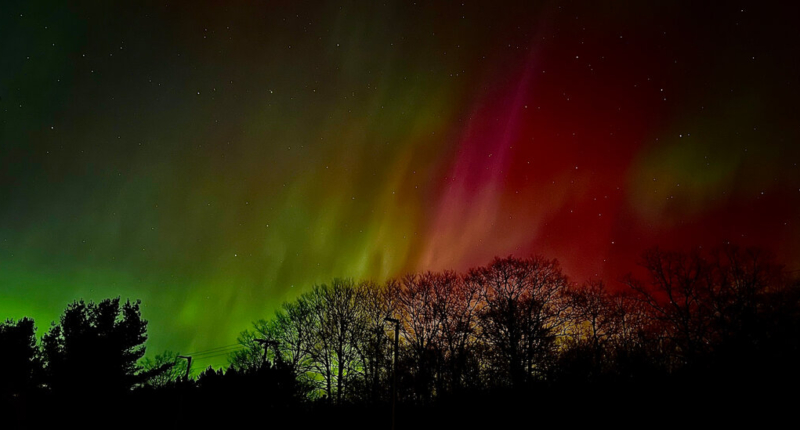A powerful geomagnetic storm caused aurora borealis to appear much farther south than usual, with the southern United States, including North Carolina and Arizona, being able to witness the colorful phenomenon. The strength of geomagnetic storms that cause auroras is difficult to predict, but typically, 50 to 100 storms of this magnitude may occur over an 11-year solar cycle, with a higher likelihood as the end of the cycle nears in 2025. Catching a glimpse of the auroras requires electrons from solar wind to hit the electrons already trapped around Earth’s magnetic field, which then acts like a slingshot. The energy comes from a coronal mass ejection, a large expulsion of plasma from the sun, which causes the magnetic field around Earth to shake, creating geomagnetic storms that produce the aurora. The colors seen in the sky are dictated by where in the atmosphere the oxygen and nitrogen hit. Green and red largely come from oxygen, and blue stems from nitrogen.
Aurora Borealis Appears Farther South in the US
The colorful northern lights, also known as aurora borealis, are typically visible in places like Alaska, Canada, and Iceland. However, on Thursday night, a powerful geomagnetic storm brought the auroras to Minnesota, New York, Virginia, Arizona, and even as far south as North Carolina. According to the Space Weather Prediction Center at the National Oceanic and Atmospheric Administration, the geomagnetic storm was rated a Level 4 on its five-tier scale.
Catching a glimpse of the auroras requires electrons from solar wind to hit the electrons already trapped around the Earth’s magnetic field, which then acts like a slingshot, says C. Alex Young, the associate director for science in the Heliophysics Science Division at NASA’s Goddard Space Flight Center. The energy comes from a coronal mass ejection, a large expulsion of plasma from the sun, which causes the magnetic field around Earth to shake, creating geomagnetic storms that produce the aurora.
The colors seen in the sky are dictated by where in the atmosphere the oxygen and nitrogen hit. Green and red largely come from oxygen, and blue stems from nitrogen. Thursday night’s auroras had purple hues and appeared joyful to James Reynolds, a professional photographer who lives just outside Asheville, N.C. Reynolds and his family decided to drive with his equipment to the Blue Ridge Parkway, a popular, scenic road about an hour from his home. After getting set up there and snapping a few shots, he finally spotted the auroras.
“It felt like the sky was alive,” said Reynolds. “It was a joyful moment to see it with the Blue Ridge Mountains and my familiar home environment in the background, where you would never expect to see something like that.”
At first, the geomagnetic storms were forecast to potentially reach only a Level 3. In the days prior, the sun had several small coronal mass ejections, but forecasters believed their impact had largely brushed past Earth. As it turned out, there had been two ejections that got closer to Earth, helping to “give it an extra kick to the Earth” when the electrons reached the magnetic field, says Dr. Young.
Aurora Borealis: The Southern US’s Rare Delight
A powerful geomagnetic storm that lasted for a couple of hours on Thursday night caused aurora borealis, also known as the Northern Lights, to appear much farther south than usual. C. Alex Young, the associate director for science in the Heliophysics Science Division at NASA’s Goddard Space Flight Center, stated that it’s difficult to determine how often such strong geomagnetic storms occur. Typically, around 50 to 100 storms of this magnitude may occur over an 11-year solar cycle, with a higher likelihood as the end of the cycle nears in 2025.
Don’t miss interesting posts on Famousbio










